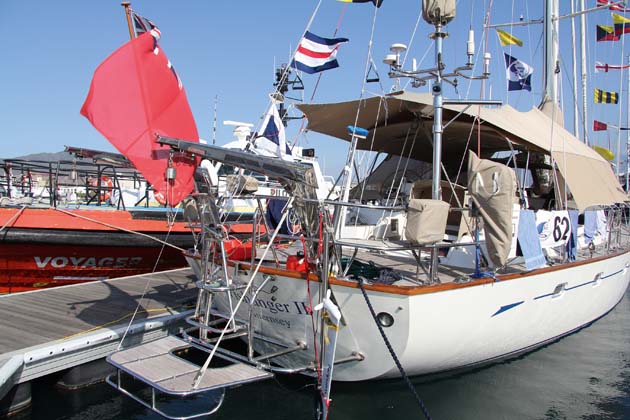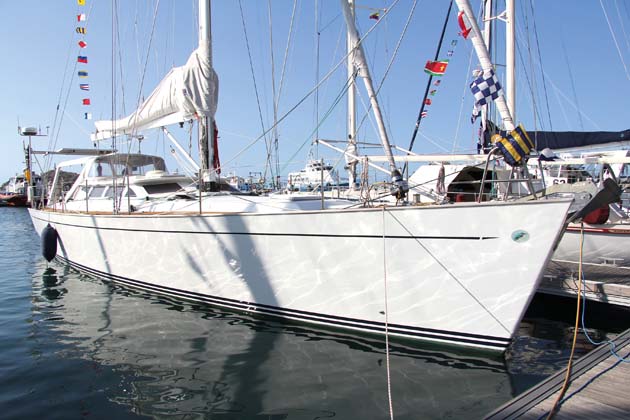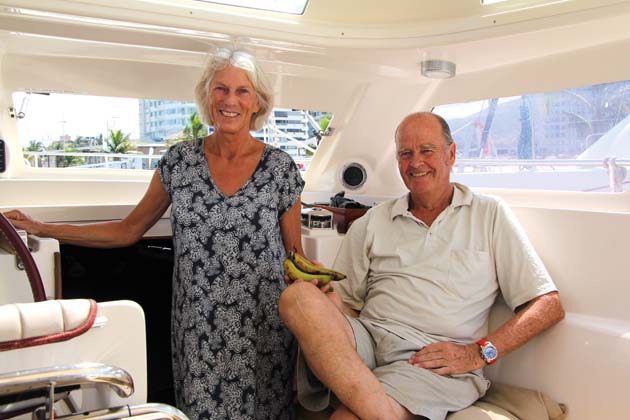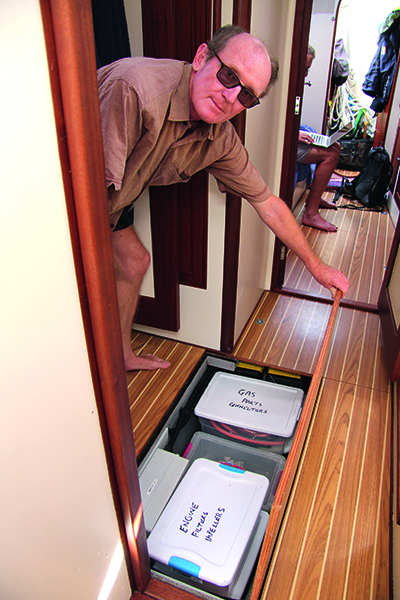Cultivating an Oyster
Oyster 62 Wishanger II

Brian Boniwell
Brian Boniwell’s Oyster 62 Wishanger II was one of the first of the marque to sport a traditional-style transom, which adds several feet to the LOA, provides more lazarette space and additional deck area.
But she has grown even more recently with the addition of a stern platform custom-designed to incorporate a mounting for the Monitor self-steering gear and the yacht’s Watt & Sea water generator. Apart from making stern boarding and embarkation possible, crew Ben Pearson said it’s ideal for landing and gutting fish.
He then took me forward to show me how Wishanger had grown at the other end. Her substantial polished stainless steel bowsprit adds another metre or so and enables an A sail to be set using a top-down furler.
They use the same line-driver furling device to deploy a Code 0 headsail. It should be said that with Pearson (24), his brother Sam (20) and friend Alex Quigley (21) in the crew there’s plenty of grunt to manage the foredeck.

Young guns – Left to right: Sam Pearson (20), Alex Quigley (21), Ben Pearson (24)
It’s a busy place because also stowed there is a 3m RIB. Extraordinarily, Brian Boniwell decided on the drastic action of cutting a hole in the bottom of the RIB so that the babstay, essential in a seaway, could be attached to its deck fitting with the tender still stowed! To free the tender the babstay is removed and a large rubber plug inserted into the substantial aperture in the bottom of the RIB.
The lads also showed me Wishanger’s new saloon modification, a vertical pole designed as a safety grab handle. It cleverly incorporates two further grab-handles on the saloon deckhead plus a net stowage area for fresh food or other items.
Belt and braces
Stimson 56 Alcedo of Ryme

David and Sally Batten
David and Sally Batten’s Stimson 56, Alcedo of Ryme arrived 16 hours astern of Spirit. Purpose-built by Martyn Brake in Dorset for short-handed, long-distance cruising, she is of an unusual composite construction. Her underwater canoe body is in strip plank wood/epoxy and her topsides and internal bulkheads in foam-cored glassfibre panels.
Apart from lightness and strength the build method was intended to be fast and economical.
Like Spirit’s owners, the Battens, both experienced cruising sailors, wanted a yacht that would perform well in light to medium offwind conditions. Weighing about 17.5 tons at launch and 23 tons loaded for the World ARC, she is a relatively light cruising yacht for her length.
Designer Chris Stimson, perhaps better known for his raceboats and now based in New Zealand, specified a big main with a long boom and, while this does indeed get Alcedo moving well, I sensed the crew were still getting used to managing this large sail when it blew.
They certainly found there was a need to reef early despite the five-ton torpedo-style bulb on her lifting keel. A late addition was a cockpit arch designed to keep the single-line mainsheet out of the cockpit. It has worked well.

The owners took a belt and braces approach to this boat, which has twin engines, twin rudders, twin autopilots and, as David put it, “a second boat beneath the sole in terms of spares – two of everything”.
His mantra that Alcedo should accommodate “four to six people for four to six weeks completely unsupported” means that there is immense stowage space for spares, frozen and fresh food.
One way of maximising space was to eschew the convention of a large owner’s cabin and instead have a utility cabin for a full-size domestic washing machine – a godsend, says Sally – large work surfaces and extra freezer space. When permitted, David can use it as a workshop.
Other essentials included:
- Safe and easy dinghy stowage for their 3m Zodiac. Davits were dismissed because of their vulnerability in a seaway so the Battens opted for a stern garage with a transom door, enabling the dinghy to be retrieved by two people and partially deflated before being stowed between the two rudder posts.
- Substantial ground tackle. Alcedo is equipped with an 80lb Rocna main anchor easily deployed from its stemhead stowage, with 100m of 3/8th chain; a secondary anchor with another 100m of chain; a kedge with 30m of 3/8th chain and a 10m span of 3/8th for general use. That should do the trick . . .
- Easy mainsail stowage. Alcedo’s fully battened Vectran main by Pete Sanders in Lymington is contained by lazyjacks and stows in a boom-mounted stack-pack style cover. It’s still a monster for two people to handle.
- A room with a view. David calculated that for 90 per cent of her life Alcedo would be used as a hotel so having a raised saloon with ‘picture windows’ was essential.

David shows off his large stock of spares
Since her launch in the UK Alcedo has crossed the Atlantic, cruised the Caribbean, sailed north to New York and returned for the start of the World ARC via the World Cruising Club’s Caribbean 1500 event from Portsmouth Virginia to Tortola in the BVIs.
The one thing they would have opted for at build stage would have been a solid, fixed doghouse in place of the canvas folding sprayhood which in practice never gets lowered. Perhaps it will in the Pacific!
Safety features first
Amel 54 Carango

Peter and Vicky Forbes
There are three Amel 54s participating in this World ARC, Peter and Vicky Forbes’s Carango being one of two aiming to complete the entire circumnavigation. A third 54 will join in Mauritius.
Recently retired from the aviation industry, Forbes, who has owned a number of yachts, chose the Amel 54 primarily for her inherent safety features.
He also liked the fact that the sailplan can be controlled entirely from the well-protected cockpit and admired the yacht’s generally well thought out and seamanlike features. Comfort and safety were more important than performance to him.
Renowned for its simplicity and absence of woodwork on deck – “you simply squirt a hose at it,” declared Forbes – the 54 aims to reduce maintenance to a minimum.
Aesthetically she could be described as a Marmite boat – you either love her or hate her. But these French-built boats have sold in their thousands.
He looked very carefully at HR, Malö, Sweden Yachts, Oyster, Discovery and Contest, but when he found Amel he dismissed the rest as all ‘grossly over-specced’.
He also revealed that he bought the yacht from Rudi Peroni of Italian beer brewing fame, complete with articles of the previous owner’s clothing and an under-sole ‘cellar’ capable of holding 480 bottles of wine. “I wouldn’t be able to wear some of the clothes ashore,” Forbes warned.
An initial refit involved new headsail roller reefing systems; SSB and AIS installation; arch-mounted solar panels; installing an active radar detection unit; buying a new liferaft and installing Fleet Broadband 250.

Peter indicates the sump into which all grey water drains before being pumped overboard via a single outlet
Although they logged more than 40 hours of motoring en route from the start in Saint Lucia, Forbes recalled some of the best sailing he’d experienced since buying Carango in May 2013. Since I spoke to him in Colombia his blog from the San Blas islands describes some equally good experiences on leg two of the World ARC.
Importantly, he and Vicky have given themselves the chance to get to know Carango since buying her and although Vicky admits to some initial ‘back-pedalling’ over the idea of the World ARC, by the time they’d reached Santa Marta she was a complete convert.
Peter Forbes reminded us of some of the Amel 54’s defining features:
- The ability to turn the mid-ship section of the yacht into a ‘citadel’ by easily closing a series of fore and aft watertight bulkhead doors and through-bulkhead valves.
- Through-hull seacocks are reduced to a minimum by draining all grey water from sinks, showers, washing machines, freezers, etc into a single sump which, by use of a float switch, automatically pumps overboard through a single above-the-waterline opening.
- Provision of a single seawater intake which then distributes water to the engine, generator, deck wash, etc via a single manifold.
- Excellent machinery access, even for a tall man like Forbes, through the cockpit sole.
- The use of mechanical gauges (as opposed to electronic) for water and fuel tanks. “Simple – what could go wrong?” asked Forbes.
- Ketch rig means shorter masts and smaller sails for a crew of a certain age.
- Standard equipment includes a dishwasher, microwave, washing machine and drier, two freezers and more.
With the ability to set a mizzen staysail and fully equipped for twin pole headsails, Carango will keep up with the help of the iron topsail when the wind drops out of the teens, but so far the match between Forbes’s crew and the Amel 54 looks ideal.





